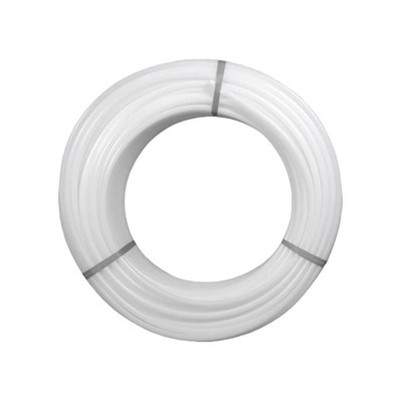Can Pex Anti UV Pipe be buried underground?
Leave a message
As a supplier of Pex Anti UV Pipe, I often encounter questions from customers regarding the feasibility of burying this type of pipe underground. In this blog post, I'll delve into the scientific aspects and practical considerations to provide a comprehensive answer.
Understanding Pex Anti UV Pipe
Pex (Cross - linked Polyethylene) pipes are widely used in plumbing systems due to their excellent flexibility, durability, and resistance to corrosion. The "Anti UV" feature in Pex Anti UV Pipe means that it has been treated or formulated to withstand the harmful effects of ultraviolet (UV) radiation. This is crucial when the pipe is exposed to sunlight, as UV rays can degrade the polymer structure of the pipe over time, reducing its strength and lifespan.


Advantages of Burying Pex Anti UV Pipe Underground
Protection from UV Radiation
One of the primary reasons for burying Pex Anti UV Pipe underground is to shield it from direct sunlight. Even though it has anti - UV properties, continuous exposure to intense sunlight can still cause long - term damage. By burying the pipe, we eliminate this risk, ensuring that the pipe maintains its integrity over a longer period.
Temperature Regulation
Underground environments tend to have more stable temperatures compared to above - ground areas. Extreme temperature fluctuations can cause pipes to expand and contract, which may lead to leaks or other structural issues. When Pex Anti UV Pipe is buried underground, it is less affected by these temperature changes, providing a more reliable plumbing solution.
Physical Protection
Burying the pipe underground offers physical protection from external factors such as accidental impacts, vandalism, and harsh weather conditions. This reduces the likelihood of damage to the pipe, which in turn minimizes maintenance and replacement costs.
Technical Considerations for Burying Pex Anti UV Pipe
Soil Conditions
The type of soil where the pipe will be buried is an important factor. Soft, loose soils may require additional support to prevent the pipe from shifting or settling unevenly. On the other hand, rocky or abrasive soils can cause scratches on the pipe surface, which may compromise its integrity. It is advisable to conduct a soil test before installation to determine the appropriate installation method.
Depth of Burial
The depth at which the Pex Anti UV Pipe should be buried depends on several factors, including local climate, soil type, and the potential for ground movement. In general, the pipe should be buried at a depth of at least 12 - 18 inches (30 - 45 cm) to provide adequate protection. However, in areas with severe frost or potential for heavy traffic, a greater depth may be required.
Backfilling
After the pipe is laid in the trench, proper backfilling is essential. The backfill material should be free of large rocks, debris, and sharp objects that could damage the pipe. A layer of sand or fine gravel can be placed around the pipe to provide a cushioning effect and prevent direct contact with the soil.
Compatibility with Other Plumbing Components
When burying Pex Anti UV Pipe underground, it is important to ensure compatibility with other plumbing components. For example, if you are using fittings, they should be made of materials that are also suitable for underground use. Our company offers a range of high - quality fittings such as the Ppsu Elbow 90°, which are designed to work seamlessly with Pex Anti UV Pipe.
Installation Best Practices
Proper Joining Techniques
Using the correct joining techniques is crucial for the long - term performance of the buried Pex Anti UV Pipe. There are several methods available, including mechanical fittings, crimping, and heat fusion. Each method has its own advantages and disadvantages, and the choice depends on factors such as the pipe size, application, and installer's preference.
Pressure Testing
Before backfilling the trench, it is essential to conduct a pressure test on the installed pipe system. This helps to identify any leaks or weak points in the system and allows for timely repairs. The pressure test should be carried out according to industry standards and local regulations.
Long - Term Performance and Maintenance
Lifespan
When installed correctly, Pex Anti UV Pipe buried underground can have a lifespan of 50 years or more. This is due to the protection provided by the underground environment and the inherent durability of the Pex material.
Maintenance
Maintenance requirements for buried Pex Anti UV Pipe are relatively low. However, periodic inspections should be carried out to check for any signs of damage or leaks. If a leak is detected, it is important to repair it as soon as possible to prevent further damage.
Our Product Range
As a leading supplier of Pex Anti UV Pipe, we offer a wide range of products to meet the diverse needs of our customers. Our PE - Xa Pipe for Plumbing Pipe is a popular choice for residential and commercial plumbing applications. It is manufactured to the highest quality standards and is available in various sizes and lengths.
We also offer PE - Xa Pipe ISO15875, which complies with international standards, ensuring its reliability and performance.
Conclusion
In conclusion, Pex Anti UV Pipe can indeed be buried underground, and it offers several advantages in terms of protection, temperature regulation, and long - term performance. However, proper installation, including consideration of soil conditions, depth of burial, and compatibility with other components, is crucial.
If you are interested in purchasing Pex Anti UV Pipe or have any questions about our products, we encourage you to contact us for a detailed discussion. Our team of experts is ready to assist you in finding the best solution for your plumbing needs.
References
- "Plastic Pipes Handbook" by B. A. Hunt
- "Cross - linked Polyethylene (PEX) Piping Systems" by the Plastics Pipe Institute




